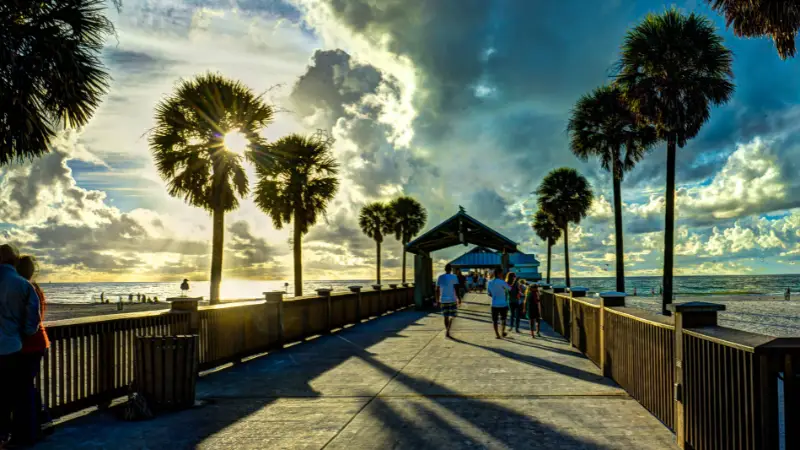Florida is known for its amazing climate that draws out numerous visitors, especially in the winter. While the state’s warmth is well-documented, you may want to know more about its wet and dry seasons so you can plan your holiday with more accuracy.
| Month: | Average Rainfall (in): |
| May | 1.54 |
| January | 1.77 |
| December | 1.78 |
Florida has a dry season and a wet season, with rainfall possible in both, but with distinct variations. If you are interested in traveling to Florida and avoiding the rain, read below to find out when you are least likely to encounter it.
What Month Does It Rain the Least in Florida?
Florida’s dry season tends to run from around halfway through October until the end of May. The wet season is usually between the end of May and the end of October but can start happening earlier in the month, depending on which part of Florida you are in.
On average, the month when it rains the least in Florida is May, with a recorded rainfall of 1.54 inches in 2021. There are some slight variations in precipitation between years, but the least rainfall tends to occur in the same months.
With Florida being such a huge tourist destination, especially for snowbirds looking for warmth in the winter, it is always best to know which months and parts of the state get the least rain.
What Are the Least Rainy Months in Florida?
There are plenty of benefits to booking a holiday in Florida, from visiting the parks to indulging in a luxurious beach holiday. Usually, the driest season on average in Florida is spring, followed by the rainiest, which is summer.
There are several least rainy months in Florida when it comes to recorded average rainfall. The driest is May, with 1.54 inches of rainfall, followed by January, with 1.77, and December, with 1.78.
As you can see, the difference between these months isn’t huge, but it stands in contrast with the rainiest months in the summer. The rainiest month in Florida tends to be July, which saw an average rainfall of 8.98 inches in 2021.
July is followed by August, with 8.78 inches, and by June, with 8.55. This shows that the wet season in Florida can be easily avoided by traveling either in spring or winter, which will keep you much drier. If you’re visiting Florida or living in Florida during these months, you can swap your beach towel and sunnies for an umbrella.
What Part of Florida Gets the Least Rain?
While knowing which month gets the least rain in Florida is helpful, you may also want to explore which parts of the state are the driest. This will increase your chances of avoiding rain when traveling to Florida.
Most of the state gets quite dry during the dry season from October to May, but you will find the driest areas in Southwest Florida and the Panhandle. The Lower Keys area is also known for being dry.
Let’s take a look at these locations and what to explore in them.
Southwest Florida
The Southwest Florida area includes various Gulf Coast counties, including Collier, Charlotte, and Sarasota. This area has some of the best beaches in the state, along with fascinating landscapes in the Everglades and amazing shopping opportunities.
Winters in Southwest Florida are particularly dry and mild, with visitors able to enjoy a magnificent beach escape where they can forget about the cold and the rain in other parts of the world.
Florida Panhandle
The Florida Panhandle can be found in the northwestern area of the state, covering from Pensacola to Apalachicola, including the state capital of Tallahassee. The driest time to visit the Panhandle is from October to December and from February to May.
Visiting the Panhandle is a great choice for those looking for idyllic white sand beaches and the breathtaking views over the Gulf of Mexico.
Lower Keys
The Lower Keys area of Florida stretches from the southeastern region of the peninsula over to Key West and even further to the Dry Tortugas. Visitors will want to stop by the Lower Keys to experience the impressive wildlife and the beautiful views.
There are also numerous wellness resorts across the area, and March is the month with the least rain in the Lower Keys.
What Month Has the Best Weather in Florida?
Visitors traveling to Florida may want to enjoy the beautiful climate without the heat and without the rain. April and May are known for being some of the best spring months to visit Florida and enjoy all the benefits, without having to pack an umbrella.
Those wishing to travel in the autumn or winter can consider October and November while making their travel plans. These four-month offer the most benefits, but sticking to the spring and the winter will always yield good results for your travels in Florida.
Final Thoughts
The month it rains the least in Florida is May, followed by January and December. The wet season occurs over the summer, with spring and winter offering the driest climate. October. November and April are also great months to do some traveling in Florida if you want to stay dry.





